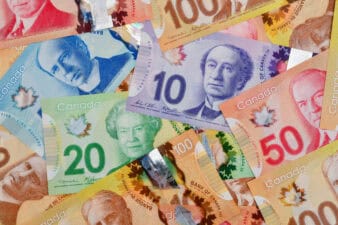The decline of oil hasn’t just left energy producers begging for mercy.
Many other sectors have taken oil’s weakness hard as well. Energy service companies have declined on fears that production cuts will strike them exceptionally hard in 2015. Pipeline companies have been weaker as well, for the same reasons.
But there’s another casualty of oil’s decline, and that’s just about every company that’s overly dependent on the province of Alberta. Boardwalk REIT (TSX: BEI.UN), which gets about 60% of its revenue from apartments located in the province, has declined nearly 20% since the beginning of November. AutoCanada, which gets approximately 50% of its revenue from car dealerships located in Wild Rose Country, has fallen even further, declining some 40% from levels reached in November.
There’s one other company that’s suffered greatly over the last month, and that’s Dream Office REIT (TSX: D.UN), one of Canada’s largest owners of office properties. Shares started November trading at $28 each, and have fallen all the way down to under $24. Let’s take a closer look at what’s caused the decline.
Weak quarterly results
2014 has been a bit of a trying year for the company. It’s been a heavy year for tenant leases expiring, which has led to some turnover.
It’s a little different turning over tens of thousands square feet of office space compared to an apartment, which can be done over a day or two. Companies need time to coordinate the move, meaning space will stay vacant for a little while between tenants. But on the plus side, leases tend to last anywhere from 3-10 years, which minimizes this risk over the long term.
Unfortunately, Dream’s third quarter had some of those issues come to light. One big tenant moved on, which led management to reduce its guidance for the fourth quarter by about a penny per share. This departure also helped push down its occupancy rate to under 94%.
Still, things aren’t looking so bad. The company reaffirmed its full year forecast of funds from operations being $2.70 in 2014, which gives it a payout ratio of 83%. Even if occupancy remains weak, there’s still plenty of excess cash flow to service the dividend.
The elephant in the room
Even though the market can be completely irrational sometimes, I don’t believe Dream’s shares declined 15% because of tepid results. Investors are worried about the future.
There are two factors that are dragging down shares. The Toronto suburban office market remains weak, and investors are worried about what energy will do to the company’s buildings in Calgary.
This is where I think the market is being irrational. Out of Dream’s more than 24 million of square feet of leasable space, 17% of it is located in suburban Toronto. Occupancy rates in the area are a little weak, coming in at 89.8%, but that’s still above the national average for all office buildings, which is 89.6%. Dream’s worst performing business is still doing pretty well.
The fear of Alberta is even more overblown. Yes, downtown Calgary occupancy fell from 94% to 90% in the quarter, but that was just from one tenant moving, and it wasn’t even an energy company — 100,000 square feet isn’t much for a company with total space of 24 million square feet.
Of course, it isn’t so much about losing one tenant, it’s about the future of office space in downtown Calgary. But even if the whole city faces weakness going forward, it’s still only 16% of Dream’s total space. It’ll hurt if energy weakens the Calgary office market going forward, but that’s the whole reason for a diversified portfolio.
Currently, Dream’s payout ratio is 83%. If earnings fall 20% from its locations in Calgary, that still leaves the payout ratio comfortably under 90%. Based on that, the dividend looks pretty secure, which makes the shares a pretty good value at this price. It’s not often investors can get a dividend over 9% that’s easily covered by earnings.







